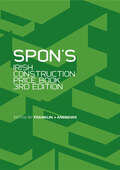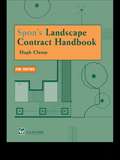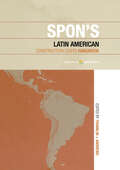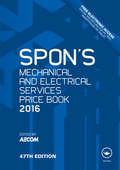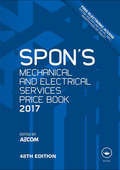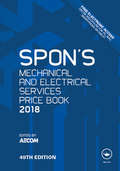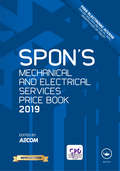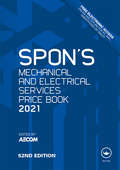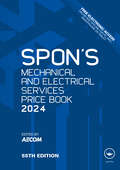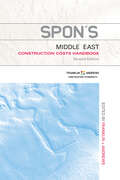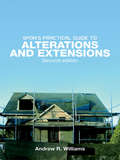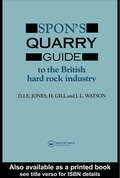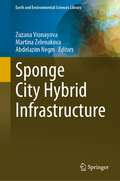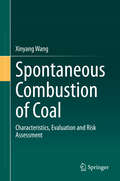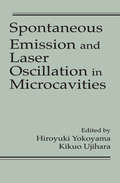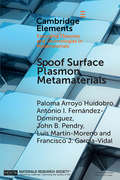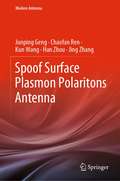- Table View
- List View
Spon's Irish Construction Price Book (Spon's International Price Books)
by Franklin AndrewsThis new edition of Spon's Irish Construction Price Book, edited by Franklin + Andrews, is the only complete, tailored and up-to-date source of cost data for the Irish construction industry. This price book is an essential aid to profitable contracting for all those operating in Ireland's buoyant construction industry.All the materials costs,
Spon's Landscape Contract Handbook: A guide to good practice and procedures in the management of lump sum landscape contracts
by Hugh Clamp H. ClampThis indispensable manual for landscape work covers the documentation and management of landscape contracts. It is written for all those involved in the landscape industry.
Spon's Landscape Handbook
by Derek Lovejoy PartnershipThere have been such great changes in legislation, official guidance, the British Standards and the techniques used in landscape and external works since the third edition was written ten years ago that the Handbook has been totally rewritten for this edition.This new edition of the Handbook provides a guide to planning and landscape law, a review of computer-aided design techniques for landscape designers, together with guidance on data to be collected during first site visits. The opportunity has been taken to change the format of the work sections to comply with SMM7 to make it easier to find specific items and to read in conjunction with the current edition of Spon's Landscape and External Works Price Book. The SMM7 sections are now divided into four parts - General Guidance, British Standards, Data and Outline Specification. Diagrams, typical drawings and photographs illustrate each section. The useful bibliography has been updated and revised.
Spon's Latin American Construction Costs Handbook (Spon's International Price Books)
by Franklin + AndrewsThis unique publication is the only detailed, multinational guide to the cost of construction work across Latin America. Countries covered are Argentina, Brazil, Chile, Colombia, Ecuador, French Guiana, Guyana, Mexico, Paraguay, Peru, Suriname, Uruguay and Venezuela.
Spon's Mechanical and Electrical Services Price Book 2016 (Spon's Price Books)
by AecomAn essential reference for everybody concerned with the calculation of costs of mechanical and electrical works. Cost Engineer The construction sector is improving. Will skills shortages derail the upturn? Spon's Mechanical and Electrical Services Price Book 2016
Spon's Mechanical and Electrical Services Price Book 2017 (Spon's Price Books)
by Aecom‘An essential reference for everybody concerned with the calculation of costs of mechanical and electrical works.’ – Cost Engineer …riding with the UK construction industry. Spon's Mechanical and Electrical Services Price Book 2017 continues to be the most comprehensive and best annual services engineering price book currently available, providing detailed pricing information across the full range of mechanical and electrical services, together with higher-level costs for a diverse range of systems and different building applications. Use the access code inside the front cover of the book to get set up with internet access to this 2017 edition until the end of December 2017. We now provide a VitalSource® ebook, giving a versatile and powerful online data viewing package. Using a combination of NRM1 and NRM2 as the measurement standards, this edition includes the following new and significantly developed items: WiFi equipment FP 600 cable Wireless fire alarms and a much enhanced clock section All the standard features you have come to expect from SPON'S MECHANICAL AND ELECTRICAL SERVICES PRICE BOOK are also included, considered essential for today’s services cost professional: detailed materials prices, labour constants, labour costs and measured work prices for mechanical and electrical works, from above ground drainage to automatic transfer switches, and circuit breakers to sprinkler systems an extensive Approximate Estimating section for quick, rule-of-thumb pricing of mechanical or electrical installations, together with elemental services costs for different types and standard of buildings full details of wage rates, daywork and cost indices on a national and Central London basis. an overhauled index and guidance notes updated, free of charge, two or three times a year – see inside for registration details. Updates are available online at www.pricebooks.co.uk Other titles in the SPON’S Price Book Series SPON’S ARCHITECTS’ AND BUILDERS’ PRICE BOOK 2017 SPON’S CIVIL ENGINEERING AND HIGHWAY WORKS PRICE BOOK 2017 SPON’S EXTERNAL WORKS AND LANDSCAPE PRICE BOOK 2017 Price Net: £160.00 (UK only)
Spon's Mechanical and Electrical Services Price Book 2018 (Spon's Price Books)
by AecomSpon's Mechanical and Electrical Services Price Book 2018 continues to be the most comprehensive and best annual services engineering price book currently available, providing detailed pricing information across the full range of mechanical and electrical services, together with higher-level costs for a diverse range of systems and different building applications. Use the access code inside the front cover of the book to get set up with a VitalSource® ebook of this 2018 edition. This versatile and powerful online data viewing package is available for use until the end of December 2018. With new cost models for a gym, a spa and a bar, this edition also includes the following new items: Solar thermal panels A physical access control barrier system A security revolving door And significant developments to Calorifiers Commercial Boilers Combined heating and power systems Heat exchangers All the standard features you have come to expect from SPON'S MECHANICAL AND ELECTRICAL SERVICES PRICE BOOK are also included, considered essential for today’s services cost professional: detailed materials prices, labour constants, labour costs and measured work prices for mechanical and electrical works, from above ground drainage to automatic transfer switches, and circuit breakers to sprinkler systems an extensive Approximate Estimating section for quick, rule-of-thumb pricing of mechanical or electrical installations, together with elemental services costs for different types and standard of buildings full details of wage rates, daywork and cost indices on a national and Central London basis. an overhauled index and guidance notes updates, free of charge, two or three times a year – see inside for registration details. Updates are available online at www.pricebooks.co.uk
Spon's Mechanical and Electrical Services Price Book 2019 (Spon's Price Books)
by AecomSpon's Mechanical and Electrical Services Price Book 2019 continues to be the most comprehensive and best annual services engineering price book currently available, providing detailed pricing information across the full range of mechanical and electrical services, together with higher-level costs for a diverse range of systems and different building applications. Use the access code inside the front cover of the book to get set up with an ebook of this 2019 edition on the VitalSource® Bookshelf platform. This versatile and powerful online data viewing package is available for use until the end of December 2019. In this 50th edition we have significantly updated the engineering features section and added a section on smart building technology. Along with the following new and significantly developed items: Tuneable white luminaires Wireless lighting control PV cells Battery storage systems All the standard features you have come to expect from SPON'S MECHANICAL AND ELECTRICAL SERVICES PRICE BOOK are also included, considered essential for today’s services cost professional: detailed materials prices, labour constants, labour costs and measured work prices for mechanical and electrical works, from above ground drainage to automatic transfer switches, and circuit breakers to sprinkler systems an extensive Approximate Estimating section for quick, rule-of-thumb pricing of mechanical or electrical installations, together with elemental services costs for different types and standard of buildings full details of wage rates, daywork and cost indices on a national and Central London basis an overhauled index and guidance notes updates, free of charge, two or three times a year – see inside for registration details. Updates are available online at www.pricebooks.co.uk ~Spon's Mechanical and Electrical Services Price Book 2019 continues to be the most comprehensive and best annual services engineering price book currently available, providing detailed pricing information across the full range of mechanical and electrical services, together with higher-level costs for a diverse range of systems and different building applications. Use the access code inside the front cover of the book to get set up with a VitalSource® ebook of this 2019 edition. This versatile and powerful online data viewing package is available for use until the end of December 2019. In this 50th edition we have significantly updated the engineering features section and added a section on smart building technology. Along with the following new and significantly developed items: - Tuneable white luminaires- Wireless lighting control- PV cells- Battery storage systems All the standard features you have come to expect from SPON'S MECHANICAL AND ELECTRICAL SERVICES PRICE BOOK are also included, considered essential for today’s services cost professional:• detailed materials prices, labour constants, labour costs and measured work prices for mechanical and electrical works, from above ground drainage to automatic transfer switches, and circuit breakers to sprinkler systems• an extensive Approximate Estimating section for quick, rule-of-thumb pricing of mechanical or electrical installations, together with elemental services costs for different types and standard of buildings• full details of wage rates, daywork and cost indices on a national and Central London basis.• an overhauled index and guidance notes• updates, free of charge, two or three times a year – see inside for registration details. Updates are available online at www.pricebooks.co.uk
Spon's Mechanical and Electrical Services Price Book 2020 (Spon's Price Books)
by AecomSpon's Mechanical and Electrical Services Price Book 2020 continues to be the most comprehensive and best annual services engineering price book currently available, providing detailed pricing information across the full range of mechanical and electrical services, together with higher-level costs for a diverse range of systems and different building applications. Use the access code inside the front cover of the book to get set up with an ebook of this 2020 edition on the VitalSource® Bookshelf platform, available for access and use until the end of December 2020. A number of new engineering features have been added: This year the lighting section has been entirely overhauled to accurately represent the latest industry standards in light fittings The three exciting areas of development AECOM has this year identified in the MEP sector -- battery storage systems, exposed services and grid decarbonisation Along with new items including MVHRs, district heating HIUs, and air source heat pumps All the standard features you have come to expect from SPON'S MECHANICAL AND ELECTRICAL SERVICES PRICE BOOK are also included, considered essential for today’s services cost professional: detailed materials prices, labour constants, labour costs and measured work prices for mechanical and electrical works, from above ground drainage to automatic transfer switches, and circuit breakers to sprinkler systems an extensive Approximate Estimating section for quick, rule-of-thumb pricing of mechanical or electrical installations, together with elemental services costs for different types and standard of buildings full details of wage rates, daywork and cost indices on a national and Central London basis. an overhauled index and guidance notes updates, free of charge, twice a year – see inside for registration details. Updates are available online at www.pricebooks.co.uk
Spon's Mechanical and Electrical Services Price Book 2021 (Spon's Price Books)
by AecomThe definitive M&E price book with additions to the measured works, updates to approximate estimating and new engineering features. Spon's Mechanical and Electrical Services Price Book 2021 continues to be the most comprehensive and best annual services engineering price book currently available, providing detailed pricing information across the full range of mechanical and electrical services, together with higher-level costs for a diverse range of systems and different building applications. Use the access code inside the front cover of the book to get set up with an ebook of this 2021 edition on the VitalSource® Bookshelf platform, available for access and use until the end of December 2021. In this year’s book: • An overhaul of the uninterruptible power supply section, and revised costs for air source heat pumps • new items including: – HDPE pipe for above ground drainage systems – fire protection mist systems – electric vehicle chargers • new engineering features: data centre cooling, later living developments, residential heat pumps, large scale heat pumps, and local energy networks • Articles on intelligent buildings to boost productivity efficiency and well being, ways data analytics is transforming BIM, digital delivery and the design process, and coronavirus and the future of work All the standard features you have come to expect from Spon's Mechanical and Electrical Services Price Book are also included, considered essential for today’s services cost professional: • detailed materials prices, labour constants, labour costs and measured work prices for mechanical and electrical works, from above ground drainage to automatic transfer switches, and circuit breakers to sprinkler systems • an extensive Approximate Estimating section for quick, rule-of-thumb pricing of mechanical or electrical installations, together with elemental services costs for different types and standard of buildings • full details of wage rates, daywork and cost indices on a national and Central London basis. • an overhauled index and guidance notes • updates, free of charge, twice a year – see inside for registration details. Updates are available online at www.pricebooks.co.uk
Spon's Mechanical and Electrical Services Price Book 2022 (Spon's Price Books)
by AecomThe definitive M&E price book with additions to the measured works, updates to approximate estimating and new engineering features. Spon's Mechanical and Electrical Services Price Book 2022 continues to be the most comprehensive and best annual services engineering price book currently available, providing detailed pricing information across the full range of mechanical and electrical services, together with higher-level costs for a diverse range of systems and different building applications. Use the access code inside the front cover of the book to get set up with an ebook of this 2022 edition available for access and use until the end of December 2022. All the standard features you have come to expect from SPON'S are also included, considered essential for today’s services cost professional: detailed materials prices, labour constants, labour costs and measured work prices for mechanical and electrical works, from above ground drainage to automatic transfer switches, and circuit breakers to sprinkler systems an extensive Approximate Estimating section for quick, rule-of-thumb pricing of mechanical or electrical installations, together with elemental services costs for different types and standard of buildings full details of wage rates, daywork and cost indices on a national and Central London basis. an overhauled index and guidance notes updates, free of charge, twice a year – see inside for registration details. Updates are available online at www.pricebooks.co.uk
Spon's Mechanical and Electrical Services Price Book 2023 (Spon's Price Books)
by AecomSpon's Mechanical and Electrical Services Price Book 2023 continues to be the most comprehensive and best annual services engineering price book currently available, providing detailed pricing information across the full range of mechanical and electrical services, together with higher-level costs for a diverse range of systems and different building applications. Use the access code inside the front cover of the book to get set up with an ebook of this 2023 edition available for access and use until the end of December 2023. Includes all the standard features you have come to expect from SPON'S are also included, considered essential for today’s services cost professional: • detailed materials prices, labour constants, labour costs and measured work prices for mechanical and electrical works, from above ground drainage to automatic transfer switches, and circuit breakers to sprinkler systems • an extensive Approximate Estimating section for quick, rule-of-thumb pricing of mechanical or electrical installations, together with elemental services costs for different types and standard of buildings • full details of wage rates, daywork and cost indices on a national and Central London basis. • an overhauled index and guidance notes • updates, free of charge, twice a year – see inside for registration details. Updates are available online at www.pricebooks.co.uk
Spon's Mechanical and Electrical Services Price Book 2024 (Spon's Price Books)
Compiled by AECOM, the 2024 edition has been updated with the latest pricing information to help you manage your projects over the next 12 months through this challenging period of high inflation and financial uncertainty. It covers the full range of mechanical and electrical services, together with higher-level costs for a diverse range of systems and different building applications. All prices have been updated via comprehensive supplier engagement combined with AECOM’s market intelligence and a short-term inflationary forecast to ensure you have the most accurate cost data available. Activity descriptions and build ups have been updated to reflect changes to standard specifications, Building Regulation changes, emerging practices, and changing outputs All the standard features you have come to expect from SPON'S are also included, considered essential for today’s services cost professional: detailed materials prices, labour constants, labour costs and measured work prices for mechanical and electrical works, from above ground drainage to automatic transfer switches, and circuit breakers to sprinkler systems an extensive Approximate Estimating section for quick, rule-of-thumb pricing of mechanical or electrical installations, together with elemental services costs for different types and standard of buildings full details of wage rates, daywork and cost indices on a national and Central London basis an updated index and guidance notes Included within the inside front cover of every book is a VitalSource® eBook redemption code giving one user access to the content digitally until the end of December 2024.
Spon's Mechanical and Electrical Services Price Book 2025 (Spon's Price Books)
Compiled by AECOM, the 2025 edition has been updated with the latest pricing information to help you manage your projects over the next 12 months through this challenging period of high inflation and financial uncertainty.It covers the full range of mechanical and electrical services, together with higher-level costs for a diverse range of systems and different building applications. All prices have been updated via comprehensive supplier engagement combined with AECOM’s market intelligence and a short-term inflationary forecast to ensure you have the most accurate cost data available. Activity descriptions and build ups have been updated to reflect changes to standard specifications, Building Regulation changes, emerging practices, and changing outputs.All the standard features you have come to expect from SPON'S MECHANICAL AND ELECTRICAL SERVICES PRICE BOOK are also included, considered essential for today’s services cost professional: detailed materials prices, labour constants, labour costs, and measured work prices for mechanical and electrical works, from above ground drainage to automatic transfer switches, and circuit breakers to sprinkler systems an extensive Approximate Estimating section for quick, rule-of-thumb pricing of mechanical or electrical installations, together with elemental services costs for different types and standard of buildings full details of wage rates, daywork and cost indices on a national and Central London basis an updated index and guidance notes Included within the inside front cover of every book is a VitalSource® eBook redemption code giving one user access to the content digitally until the end of December 2025.
Spon's Middle East Construction Costs Handbook (Spon's International Price Books)
by FranklinThe indispensable guide to building costs in Bahrain, Egypt, Iran, Iraq, Jordan, Kuwait, Lebanon, Libya, Oman, Qatar, Saudi Arabia, Syria and the UAE. Features detailed information across all sectors and by individual country, plus comparative information.
Spon's Practical Guide to Alterations & Extensions
by Andrew R. WilliamsThe procedures, the problems and pitfalls of extending or altering property are discussed in this fully updated new edition. The author gives helpful advice on how to make the project go smoothly from beginning to end. This is a practical guide for those at the beginning of their career in building, or who want to be updated on the new regulations now in force. This new edition incorporates the 2005 Amendments to Approved Document L1B on the conservation of fuel and power. Developments in Computer Aided Design and structural calculations are also discussed. It is invaluable to all those who are trying to act efficiently, correctly and cost-effectively.
Spon's Quarry Guide: To the British hard rock industry
by H. Gill Mr D Jones D.I.E. Jones J.L. WatsonSpon's Quarry Guide provides complete and up-to-date information on all of Britain's hard rock quarrying industry. For over 700 quarries it gives full address, OS Map Number and grid reference, telephone and contact names. Rock type, colour, grain and products are listed. The Guide also gives, for the first time in any publication, the plant and eq
Spon's Railways Construction Price Book (Spon's Price Books)
by Franklin + AndrewsOver £6 billion is scheduled for investment in the UK's railway infrastructure over the next few years, with £1.2 billion committed to enhancement projects, £1.3 billion to infrastructure maintenance and £1.2 billion on track renewals. Significant investment is also planned in signalling, telecommunications, electrification, stations and depot buildings. Bidding for, winning and completing this work requires an accurate knowledge of the costs, work and resources involved. Spon's Railways Construction Price Book provides that knowledge. Any company looking to participate in the regeneration of the UK's railway network, will find the guidance provided here an essential strategic asset. Compiled from years of specialist experience, this book provides an understanding of the key drivers and components that affect the cost of railway projects. The first edition rapidly became essential reading for designers, engineers, surveyors, project managers, contractors and all those involved in the railway industry. This improved and extended second edition is destined to take its place.
Sponge City Hybrid Infrastructure (Earth and Environmental Sciences Library)
by Martina Zelenakova Abdelazim Negm Zuzana VranayovaThis book focuses on the access to water in the building and its surroundings, to infer the mutual interaction and the complex interconnection of green/blue infrastructures. This book is a tool for understanding the multifunctional functionality of urban waste water to recognize their efficient and strategically useful potential in the form of aesthetic and functional architectural elements—vertical gardens, waterproof roof systems, rain gardens, retention rainwater recirculation tanks, biomarkers for wastewater treatment, and other progressive technologies and technical solutions. The originality of the proposed book and the innovation of the proposed objectives lies in the complexity and interdisciplinary of the problem solved, with clear continuity and utilization in professional building, environmental, and psychosocial practice. Understanding the quality of life as a category influenced by several objective and subjective conditions, this manuscript draws up recommendations on how to build “green buildings”—progressively supplied with water, connecting infrastructures—from existing buildings (administrative or training).
SpongeBob Airpants: The Lost Episode (SpongeBob SquarePants #8)
by Kitty RichardsSpongeBob SquarePants It's a bird! It's a plane! It's . . . SpongeBob! SpongeBob dreams of flying with the jellyfish. And this time he sets out to make his dream a reality. From a makeshift flying machine to a hapless bat costume, SpongeBob's airborne attempts are grounded until he accidentally invents a pair of superherolike flying pants. But SpongeBob soon realizes that being a superhero isn't all it's cracked up to be. Will he ever be able to live as a mere mortal again? Find out in this aerodynamic adventure!
Spontaneous Combustion of Coal: Characteristics, Evaluation and Risk Assessment
by Xinyang WangThis book aims to understand, analyze and mitigate the harmful impacts of spontaneous coal combustion in underground mines, a thermal phenomenon that triggers fires and explosions threatening the safety of mine workers globally. Based on experimental and theoretical research findings, the book emphasizes three essential questions that are fundamental to understand spontaneous coal combustion: What are the root causes? How to evaluate the causative factors to determine the activity of coal? and How to bring this issue under control in real longwall panel? Readers are introduced to experimental techniques applied to investigate the basic molecular structure of coal and evaluate chemical properties that induce self-heating behavior, theoretical analyses to predict the extrinsic effect on low temperature oxidation of coal in experimental scale and full-size longwall panel, and preventive measures to mitigate this issue using methods for retardant screening, numerical simulations for optimal grouting and nitrogen injections, and case studies analyzing thermal events using mine atmosphere gas monitoring data. The book will be of interest to students and researchers studying mining engineering and chemistry, as well as engineers and practitioners involved in coal mine development and risk assessment.
Spontaneous Emission and Laser Oscillation in Microcavities (Laser And Optical Science And Technology Ser. #10)
by Kikuo Ujihara Hiroyuki YokoyamaIn spite of the increasing importance of microcavities, device physics or the observable phenomena in optical microcavities such as enhanced or inhibited spontaneous emission and its relation with the laser oscillation has not been systematically well-described-until now. Spontaneous Emission and Laser Oscillation in Microcavities presents the basics of optical microcavities. The volume is divided into ten chapters, each written by respected authorities in their areas. The book surveys several methods describing free space spontaneous emission and discusses changes in the feature due to the presence of a cavity. The effect of dephasing of vacuum fields on spontaneous emission in a microcavity and the effects of atomic broadening on spontaneous emission in an optical microcavity are examined. The book details the splitting in transmission peaks of planar microcavities containing semiconductor quantum wells. A simple but useful way to consider the change in the spontaneous emission rate from the viewpoint of mode density alteration by wavelength-sized cavities is provided. Authors also discuss the spontaneous emission in dielectric planar microcavities. Spontaneous emission in microcavity surface emitting lasers is covered, as are the effects of electron confinement in semiconductor quantum wells, wires, and boxes also given. The volume extends the controlling spontaneous emission phenomenon to laser oscillation. Starting from the Fermi golden rule, the microcavity laser rate equations are derived, and the oscillation characteristics are analyzed. Recent progress in optical microcavity experiments is summarized, and the applicability in massively optical parallel processing systems and demands for the device performance are explored. This volume is extremely useful as a textbook for graduate and postgraduate students and works well as a unique reference for researchers beginning to study in the field.
Spontaneous Symmetry Breaking, Self-Trapping, and Josephson Oscillations
by Boris A. MalomedThis volume collects a a number of contributions on spontaneous symmetry breaking. Current studies in this general field are going ahead at a full speed. The book present review chapters which give an overview on the major break throughs of recent years. It covers a number of different physical settings which are introduced when a nonlinearity is added to the underlying symmetric problems and its strength exceeds a certain critical value. The corresponding loss of symmetry, called spontaneous symmetry breaking, alias self-trapping into asymmetric states is extensively discussed in this book. The book presents both active theoretical studies of spontaneous symmetry breaking effects as well as experimental findings, chiefly for Bose-Einstein-Condensates with the self-repulsive nonlinearity, and also for photorefractive media in optics.
Spoof Surface Plasmon Metamaterials (Elements of Emerging Theories and Technologies in Metamaterials)
by Luis Martin-Moreno Paloma Arroyo Huidobro John B. Pendry Antonio I. Fernandez-Dominguez Francisco J. Garcia-VidalMetamaterials offer the possibility to control and manipulate electromagnetic radiation. Spoof surface plasmon metamaterials are the focus of this Element of the Metamaterials Series. The fundamentals of spoof surface plasmons are reviewed, and advances on plasmonic metamaterials based on spoof plasmons are presented. Spoof surface plasmon metamaterials on a wide range of geometries are discussed: from planar platforms to waveguides and localized modes, including cylindrical structures, grooves, wedges, dominos or conformal surface plasmons in ultrathin platforms. The Element closes with a review of recent advances and applications such as Terahertz sensing or integrated devices and circuits.
Spoof Surface Plasmon Polaritons Antenna (Modern Antenna)
by Jing Zhang Kun Wang Junping Geng Chaofan Ren Han ZhouThis book investigates in detail some new spoof surface plasmon polaritons (SSPPs) structures and their applications to antenna. It introduces the working principle and radiation characteristics of directional antenna, omnidirectional antenna, reconfigurable antenna and phase-mode antenna based on SSPPs structure. Especially, the irregular SSPPs structure, such as T-shaped and m-shaped SSPPs structures, is introduced to low-profile end-fire antenna with vertical polarization; the rotated SSPPs structure is applied to CP end-fire antenna and omnidirectional antenna; PIN circuit combining with SSPPs structure is used to pattern reconfigurable antenna; the novel phase-mode SSPPs antennas with multi-modes are performed too. This book proposes a continuous method to develop the potentialities of the SSPPs antenna. And the readers can study the method or ideas of the SSPPs antenna, even graft the methods to other SSPPs antenna. The book is intended for undergraduate and graduate students who are interested in SSPPs antenna technology, researchers investigating high-performance antenna, and antenna design engineers working on multi-function antenna applications.
